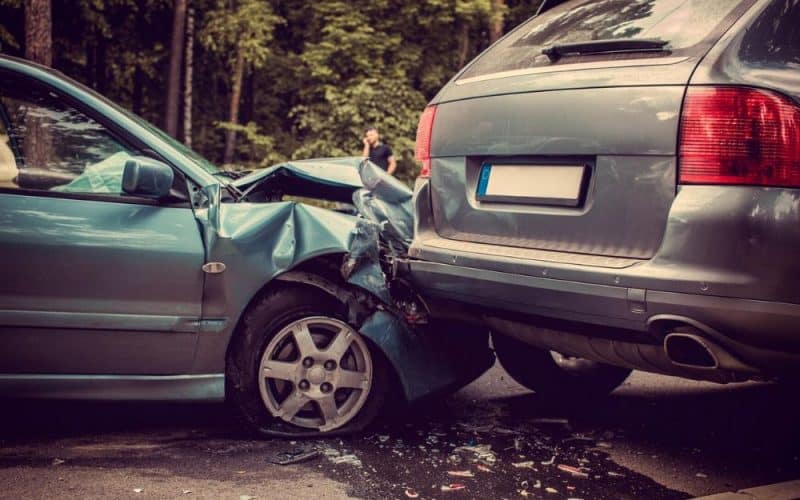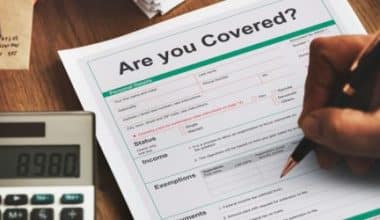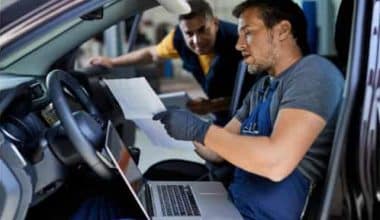An at-fault accident is a car accident caused by a driver’s negligence. When a collision occurs, it’s important to determine which driver(s) acted in a way that caused the crash. A driver whose behavior led to the accident is considered to be at fault.
In an at-fault accident, the driver who was to blame is responsible for compensating accident victims for losses.
There were 38,824 people killed in motor vehicle accidents and 2.28 million people injured in crashes in 2020, according to the National Highway Traffic Safety Administration. Many of these crashes were caused by at least one driver breaking the rules of the road or making careless decisions.
At-Fault accident: An overview
An at-fault accident is a collision caused by a driver’s negligence. In most, but not all states, crash victims are able to recover compensation for injuries from the driver who caused the collision after an at-fault accident occurs.
Legally, negligence is failing to take reasonable care to prevent harm to another person. This could mean you failed to do something, such as stopping at a red light, or you did something careless, like driving while fatigued.
Other examples of negligence on the road include:
- Driving under the influence of drugs or alcohol.
- Speeding.
- Texting and driving.
What does fault mean?
In car accident cases, fault has a specific legal meaning. A driver is at fault for an accident if:
- The driver failed to fulfill his basic obligation to behave with a reasonable degree of care on the road. If the motorist behaved less safely than the average reasonable person would have, that motorist is said to be “negligent.”
- The driver’s negligence was the direct cause of the motor vehicle accident
Many different types of behaviors can result in a driver being found to be at fault for an accident. These include:
- Driving while drunk or on drugs
- Speeding
- Distracted driving
- Failure to obey traffic signals or other rules of the road
- Following another car too closely
- Not yielding to drivers or pedestrians who have the right of way
Accidents in at-fault states
In an at-fault state, also called a tort state, a driver who causes a car accident is responsible for compensating the other party or parties for their losses. This can be done with an insurance claim or the at-fault driver can pay the other party out of pocket.
If you cause a collision and use your insurance to pay for the damages, the property damage liability portion of your policy is designed to pay for the other driver’s vehicle damages. Your bodily injury liability insurance is designed to pay for the other driver’s and passengers’ medical expenses if they are injured. These coverage types will only pay up to the limits on your policy and any overage is your responsibility to pay out of pocket.
Depending on if you have full coverage, your insurance policy might also pay for the damages to your car. If you have PIP or medical payments coverage, your policy can also help pay for your injuries and the injuries of your passengers, up to your policy limit.
Accidents in no-fault states
Contrary to the name, fault does still exist in no-fault states. No-fault insurance only refers to injuries that occur in accidents. Drivers are still liable for the property damage they cause if they hit someone.
In a no-fault state, drivers are required to buy a type of auto insurance called Personal Injury Protection (PIP). When a crash happens, everyone involved makes a claim with their own insurer to get their injury-related costs covered by their PIP insurance. This happens regardless of who is to blame.
After an accident in a no-fault state, both drivers’ insurance companies will pay for their respective insured’s medical expenses using their PIP coverage, regardless of which driver caused the collision. However, the at-fault driver is responsible for compensating the other driver for their car repairs using property damage liability coverage.
Within these no-fault states, a collision victim cannot sue a driver for injury-related losses unless the damage is very severe. The specific rules for when a victim can pursue a claim against the other driver vary but often focus on the severity and permanence of the injuries and/or costs associated with treatment.
Proving fault for a car accident
Determining fault is important in all collisions, even in no-fault states. Even in no-fault states, the driver responsible for the crash still must provide compensation for property damage and could still be sued for serious injuries.
In states with at-fault accident rules, the driver who caused the accident will have to fully compensate victims for both property damage and personal injuries.
There are a number of different types of evidence that can be evaluated to determine who is at fault for a collision. This can include:
- Statements from the drivers involved in the accident
- Witness statements from observers
- A police report written at the scene of the collision
- Photos and videos from the crash scene
- Skid marks on the roadway
- The type and location of damage to the vehicles
- Evidence from the accident scene such as blood or debris on roadways
If an accident victim wishes to pursue compensation after an at-fault accident, it’s their responsibility to make a convincing case that the other motorist was to blame. An experienced car accident attorney can help victims succeed in accomplishing this important goal in an at-fault accident case.
How fault is determined after a crash
Typically, an insurance adjuster will look at evidence such as police reports, vehicle damage, and even weather conditions to determine how much a driver is at fault. Often, both drivers carry some degree of responsibility.
Before reaching a settlement, auto insurers must take into account negligence laws, which differ by state. These laws determine if you can seek payment from another driver after an accident and how much you can request. Different negligence laws include:
- Contributory. If you’re responsible for an accident, even if you’re only 1% at fault, you can’t seek compensation from another driver.
- Pure comparative. You can seek payment if you are at fault, but the amount will depend on your degree of responsibility. For instance, if you were 30% at fault for a crash, you can receive payment for only 70% of your vehicle repairs or medical bills.
- Modified comparative. You can seek compensation as long as you weren’t at fault for more than 50% or 51% of the accident, depending on the state. For example, if you were 60% responsible for a crash, you would not be able to seek payment from the other driver.
- Slight/gross comparative. You can seek compensation if your negligence was “slight” and the other driver’s was “gross.” There is no set standard for what is considered slight or gross.
What if both sides are at fault?
Sometimes, drivers share fault for a collision. If this happens, the rules about when victims can recover compensation for crashes vary by state. One of three legal rules could apply:
- Contributory negligence. This legal doctrine applies in a minority of states. In a contributory negligence state, if a driver is even partly responsible for causing the accident, he or she can’t get compensation from the other motorist. This means someone who is 1% responsible would be barred from recovering any damages from the driver who was 99% to blame.
- Pure comparative fault states. In states with this legal rule, victims can always pursue compensation even if they are mostly to blame. If a driver was 75% responsible for causing a crash, he could still make a claim to recover from the other driver. His compensation would just be reduced by 75%. So, if he sustained $100,000 in damages, he could recover $25,000 from the driver party to blame for the collision.
- Modified comparative fault states. In these states, drivers who are partly responsible for their own injuries can recover compensation for a portion of the damages. However, this is allowed only if the other driver was at least 50% responsible or at least 51% responsible, depending on the location
Cases where multiple parties are at fault for a collision can be especially complicated, so it’s important to get the right legal help in these situations.
Insurance after an at-fault accident
In most states, the driver at fault will have to pay for the other person’s injuries and any damage to their vehicle. This is covered by your liability insurance, which all drivers must have in every state except Alaska, New Hampshire and Virginia. Virginia waives the requirement if you pay a $500 fee, and Alaska exempts certain drivers.
Meanwhile, New Hampshire drivers must prove they can pay for the other driver’s property damage and injuries in an at-fault accident.
However, liability coverage won’t pay for your medical bills if you’re at fault. Instead, your health insurance or medical payments coverage will pay for any injuries you have from an at-fault accident.
Timeline for pursuing a claim in an at-fault accident
If you are involved in an at-fault accident, you have a limited amount of time to act to pursue a claim.
There’s a statute of limitations that applies to injury cases and you must act before it or your claim is time-barred and not allowed to move forward. The exact time limit varies by location. However, the statute of limitations is usually two to four years from the time of the at-fault accident.
Acting quickly is best so you can more easily collect evidence to prove your case so contact an attorney as soon as possible after a collision.
What losses will insurance cover?
The compensation available after a car accident varies depending on whether it was an at-fault accident or not.
If you live in a no-fault state and your injuries are minor, you can get your medical bills paid and partially lost wages covered by Personal Injury Protection (PIP) and get your property damage losses paid for by the driver who caused the accident.
If you live in a fault state, you can pursue a claim against the driver who caused the collision and recover compensation for:
- Medical bills
- Lost wages
- Pain and suffering
- Emotional distress
- Property damage
Those who live in no-fault states and who sustain serious injuries may also be able to sue to recover these types of compensation if they meet their state’s requirements.
How to obtain compensation
If you are involved in an at-fault accident and wish to pursue a claim against the other driver, there are a few options for recovering compensation:
- You could negotiate a settlement with the at-fault driver’s insurance company. This would mean the insurer agrees to pay a lump sum amount and you agree to give up any further claims in exchange for the money.
- You could pursue an injury claim in court and receive damages the court feels are appropriate if you prove your case
In many situations, you may file a lawsuit and then end up settling before the case makes it to trial. An experienced auto accident lawyer can help you to negotiate a settlement or take your case to court if doing so becomes necessary to get the compensation you deserve.
Recommended Articles
- What Is Liability Car Insurance: Meaning & What It Covers
- Life Insurance For High Risk: How Does It Work?
- What Is A Car Insurance Premium & How Does It Work?
- Self-employed Business Insurance: Cost, Types & Coverage
- Liability or Full-Coverage Car Insurance: Which Is Better?
- Car Insurance With No License: Can You Get It & How?
- Electric Car Insurance: How Does It Work?






